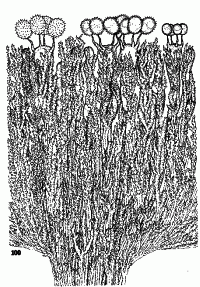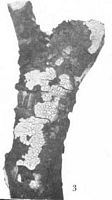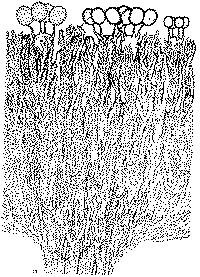|
 Aleurodiscus coralloides Aleurodiscus coralloides
SynonymsAcanthophysium coralloides
BiostatusPresent in region - Indigenous. Endemic
Images (click to enlarge)
Caption: FIG. 100. Acanthophysium coralloides. Showing numerous types of coralloid
acanthophyses forming the bulk of the context, basidia, and paraphyses arranged in a
scanty palisade, and large subglobose aculeate spores. | 
Caption: PLATE I. FIG. 5. Acanthophysium coralloides, × 1
Coalesced colonies forming the effused hymenophore. | 
Caption: Pl. 26, fig. 3. Aleurodiscus coralloides, x 1. | 
Caption: FIG. 11. Aleurodiscus coralloides. Transverse section showing arrangement of hyphae arising
from point of attachment, coralloid acanthophyses of diverse types, and submerged
paraphyses, x 500. | |
Article: Cunningham, G.H. (1963). The Thelephoraceae of Australia and New Zealand. New Zealand Department of Scientific and Industrial Research, Bulletin 145: 359 p. Wellington:.
Description: Hymenophore annual, cretaceous, adherent, at first composed of numerous small
orbicular scattered colonies 1-2 mm diameter, soon coalescing to form effused areas
to 15 x 3 cm; margin thinning out, irregular, arachnoid, adherent; hymenial surface
chalk-white, sometimes tinted cream or pallid pink, deeply areolately creviced, even
or finely tuberculate. Context white, to 0.5 mm thick, intermediate layer of loosely
arranged erect hyphae radiating from points of attachment, embedding masses of
crystals; generative hyphae 3-6 µ diameter, walls 0.5 µ thick, or lumena almost
capillary, with clamp connections. Acanthophyses coralloid, branched, freely spinose,
varying in shape and size, arising from hyphae of the context at different levels,
projecting, lumena capillary. Gloeocystidia absent. Hymenial layer vaguely defined, to
80 µ deep, a scanty palisade of basidia, paraphyses, and acanthophyses. Basidia
subclavate, often distorted and genlculated, soon collapsing, 60-115 x 15-26 µ
bearing 4 spores; sterigmata arcuate, subulate, to 24 µ long. Paraphyses subclavate,
scanty, buried in the context, 40-110 x 8-12 µ. Spores commonly oval, many
subglobose, a few globose, 18-25 x 16-22 µ, walls irregularly aculeate, 1 µ thick,
amyloid, spines to 3 µ long.
Habitat: HABITAT: Effused on bark of dead branches, twigs and standing dead saplings.
Distribution: TYPE LOCALITY: Mt. Tongariro, Wellington, New Zealand.
DISTRIBUTION: New Zealand.
Notes: A. coralloides is common in New Zealand on four endemic species of Nothofagus. It
may be identified by the chalk white (sometimes pink) deeply creviced hymenophore,
oval irregularly aculeate spores, and thick-walled acanthophyses. The hymenophore,
although appearing effused, is in reality composed of many small orbicular coalesced
colonies. In sections each colony is apparent since the context hyphae develop from a
small submerged base, and are arranged radiately from its centre. Hyphae merge with
those of neighbouring colonies, at points of coalescence being less densely
compacted. On the surface, margins of colonies are indicated by deep crevices.
Acanthophyses are produced in such masses that the scanty hymenium is masked, and
give to sections their characteristic chalky appearance. They simulate pieces of coral,
being short-branched, both stems and branches bearing spines and possessing walls so
thickened that lumena are capillary. An almost endless variety of shapes may be seen
in any section, so that exact descriptions are difficult to prepare. Among the
acanthophyses are embedded the paraphyses and young basidia. The latter, when
mature, elongate and project above the hymenial surface, produce spores, then
collapse. Spores are formed in large numbers and may be found lying upon the surface
and scattered through the hymenial tissues. Although appearing almost smooth in
lactic acid aniline blue mounts, they are seen to be coarsely and irregularly aculeate
when treated with Melzer's reagent.
Article: Cunningham, G.H. (1956). Thelephoraceae of New Zealand. Part XI. The genus Aleurodiscus. Transactions of the Royal Society of New Zealand 84(2): 237-268.
Description: Hymenophore resupinate, annual, cretaceous, adnate, at first composed of numerous small
orbicular scattered colonies 1-2 mm diameter, soon coalescing to form effused linear areas to
15 x 3 cm; margins thinning out, irregular, arachnoid, adnate; hymenial surface chalk-white,
sometimes tinted cream or pallid pink, deeply areolately creviced, crevices following lines of
coalescence, even or irregularly tuberculate. Context white, to 0.5 mm thick, composed of
loosely arranged hyphae radiating from points of attachment, embedding masses of crystals;
generative hyphae 3-6 µ diameter, walls 0.5 µ thick, or lumen almost capillary, hyaline,
branched, septate, with clamp connexions. Hymenial layer vaguely defined, to 80 µ deep, a
scanty palisade of basidia, paraphyses and acanthophyses. Basidia subclavate, often distorted
and geniculated, projecting, soon collapsing, 60-115 x 16-26 µ, 4-spored; sterigmata arcuate,
subulate, to 24 µ long. Paraphyses subclavate, scanty, buried in the tissues, to 110 x 12 µ.
Acanthophyses coralloid, branched, freely spinose, varying in shape and size, arising from the
hyphae of the context and at different levels, projecting, lumen capillary. Gloeocystidia
absent. Spores commonly oval, many subglobose, a few globose, 18-25 x 16-22 µ, walls
irregularly aculeate, 1 µ thick, hyaline, amyloid, spines reaching a length of 3 µ.
Habitat: HABITAT. Effused on bark of dead branches, twigs and standing dead saplings.
Distribution: DISTRIBUTION. New Zealand.
Notes: Three of the effused resupinate species present in New Zealand may be grouped by the
coralloid acanthophyses, namely A. coralloides, A. coronatus and A. sparsus. The first is
common on four endemic species of Nothofagus and may be identified by the chalk-white or
pink deeply creviced hymenophore, oval, irregularly aculeate spores and thick-walled
acanthophyses. The hymenophore, though effused, is in reality composed of numerous small,
coalesced, orbicular colonies. In sections each individual may be recognized since the context
hyphae develop from a small submerged base, and are arranged radiately from its centre.
Hyphae merge with those of neighbouring colonies, at points of coalescence being less
densely compacted. On the surface margins of the colonies are indicated by deep crevices.
Acanthophyses are produced in such masses as to mask the scanty hymenium. They simulate
branches of coral, being short-branched, both stems and branches bearing spines and
possessing walls so thickened that the lumen is capillary. An almost endless variety of shapes
may be seen in any one section, so that exact descriptions are not easy to draw. Among the
acanthophyses are buried the paraphyses and young basidia. The latter, when mature, elongate
and project above the hymenial surface, produce spores, then collapse. Spores are produced in
large numbers and may be found lying upon the surface and scattered through the hymenial
tissues. Although appearing almost smooth in lactic acid aniline blue mounts they are seen to
be coarsely and irregularly aculeate when treated with Melzer's reagent. The abundant
acanthophyses give to the hymenial surface and to sections their chalky appearance, and
because of their characteristic form, the specific name has been given.
|